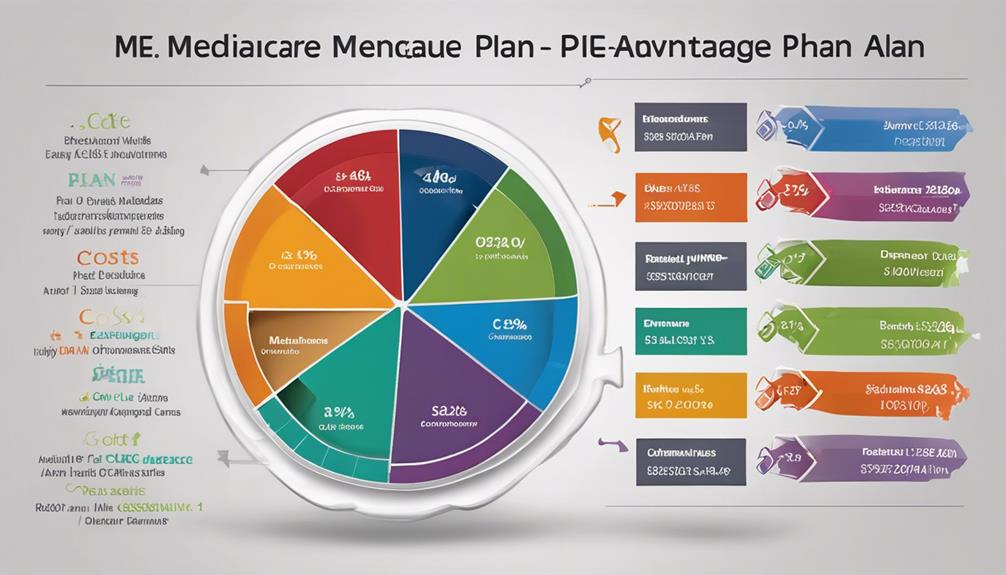Is the popular saying, “What goes around comes around,” familiar to you? In regards to Medicare costs, it is important to realize that it is not only about the amount you pay, but also about acknowledging the benefits you receive in return.
Medicare expenses can vary depending on the parts and plans you choose, impacting your overall healthcare budget. So, before making any decisions, it's crucial to grasp the full picture of how much Medicare may cost you and how it aligns with your healthcare needs.
Key Takeaways
- Part A premiums range from $0 to $505 monthly.
- Part B standard premium is $174.70 per month.
- Medicare Advantage plans offer extra benefits.
- Medigap provides supplemental coverage for Medicare beneficiaries.
Overview of Medicare Cost Components
In analyzing the components of Medicare costs, it becomes evident that they encompass various premiums, deductibles, and coinsurance obligations.
Medicare Part A typically has a premium of $0 for most eligible individuals, although some may face premiums of $278 or $505 monthly. The Part A deductible stands at $1,632 per inpatient hospital benefit period, with copayments for inpatient stays, skilled nursing facilities, and home health care.
Moving to Medicare Part B, the monthly premium is $174.70, along with an annual deductible of $240 and a 20% coinsurance for covered services. For those opting for Medicare Advantage plans, premiums and out-of-pocket limits vary, but individuals are still required to pay the Part B premium.
When it comes to Part D prescription drug coverage, costs differ by plan, with penalties for late enrollment. Assistance based on income is available to help individuals manage these expenses effectively.
Medicare Part A Cost Breakdown

Breaking down the costs of Medicare Part A reveals key financial components crucial for understanding healthcare expenses associated with this coverage. Medicare Part A costs include various elements that enrollees should be aware of to effectively manage their healthcare expenses.
Here are some important aspects to consider:
- Premium: Most eligible individuals pay $0 premium for Medicare Part A, but for some, the monthly premium can be $278 or $505.
- Deductible: The deductible for Part A is $1,632 per inpatient hospital benefit period.
- Copayments: Copayments for inpatient stays can range from $0 to paying all costs after day 150. Additionally, for skilled nursing facility stays, copayments are $0 for days 1-20 and $204 per day for days 21-100.
Understanding these cost breakdowns can help individuals anticipate and plan for their healthcare expenses under Medicare Part A effectively. By being informed about these financial aspects, beneficiaries can make more informed decisions regarding their healthcare needs.
Medicare Part B Cost Breakdown
Analyzing the financial components of Medicare Part B reveals key details essential for understanding healthcare expenses associated with this coverage. For Medicare Part B in 2024, the standard monthly premium is $174.70, and the annual deductible is $240. Beneficiaries with higher incomes may face an Income-Related Monthly Adjustment Amount (IRMAA) for Part B premiums. Additional payments could also be required for specific services, such as immunosuppressive drugs, which have a premium of $103.00. Understanding this Medicare Part B cost breakdown is crucial for budgeting and planning healthcare expenses effectively.
| Component | Cost |
|---|---|
| Part B Premium | $174.70/month |
| Annual Deductible | $240 |
| IRMAA (Income-Related Adjustment) | Variable |
| Additional Payments (e.g., drugs) | $103.00 |
| Total Monthly Cost (Standard Premium + Additional) | $277.70 |
Understanding Medicare Advantage Plan Costs

Transitioning from analyzing Medicare Part B costs, understanding Medicare Advantage plan costs is essential for individuals considering alternative healthcare coverage options. Medicare Advantage plans come with various costs that beneficiaries need to consider before enrolling. Here are three key points to help you grasp the expenses associated with these plans:
- Monthly Premiums: Medicare Advantage plans may have monthly premiums that need to be paid in addition to the Part B premium.
- Out-of-Pocket Limits: These plans have yearly out-of-pocket limits that act as a safety net to protect you from high medical expenses.
- Additional Benefits: Some Medicare Advantage plans offer $0 premium options, providing extra benefits such as dental, vision, and hearing coverage.
Understanding the costs involved in Medicare Advantage plans is crucial for making informed decisions about your healthcare coverage. It's important to review the plan's documentation carefully to get a detailed overview of the expenses, coverage, and enrollment requirements.
Exploring Medicare Part D and Medigap Costs
Exploring the costs associated with Medicare Part D and Medigap policies provides valuable insight into the financial considerations of enhancing one's healthcare coverage.
Medicare Part D premiums can vary significantly by plan, with an average cost of around $55.50 per month in 2024. It's crucial for Medicare beneficiaries to be aware that late enrollment in Part D may lead to a penalty based on the duration without coverage.
On the other hand, Medigap policies offer supplemental insurance with varying monthly premiums influenced by factors like location and covered benefits. Medigap helps cover expenses such as deductibles and coinsurance that aren't paid by Original Medicare, providing additional financial protection for those enrolled.
Many Medicare beneficiaries choose to opt for Medigap plans to bolster their Part A and Part B coverage, ensuring they've comprehensive coverage and financial security in the face of healthcare expenses. Understanding the nuances of Medicare Part D premiums and Medigap policy costs is essential for making informed decisions about healthcare coverage.
Frequently Asked Questions
How Much Does Medicare Cost on Average per Month?
On average per month, Medicare costs vary with factors like the specific plans selected.
Premiums for Medicare Part B average $174.70, while Medicare Advantage plans average $18.50.
Additionally, Medicare Part D prescription drug plans have an average premium of $55.50 monthly.
Most individuals don't pay a premium for Medicare Part A.
The total monthly cost for Medicare coverage can differ based on the chosen plans and options.
Is Medicare Part B Free at Age 65?
At age 65, Medicare Part B isn't free. Most of us will pay a standard monthly premium, which was $174.70 in 2024. This coverage is crucial for medical needs. While it's not without cost, the benefits outweigh the fees.
Deductibles and coinsurance also factor into the total expenses, making it essential to budget for healthcare needs. Additional adjustments may apply based on income.
How Much Will My Medicare Part B Cost?
When considering Medicare Part B, costs vary based on income and potential adjustments. Premiums for 2024 stand at $174.70 per month, with a $240 annual deductible. Individuals with higher incomes might face additional fees through the Income-Related Monthly Adjustment Amount (IRMAA).
Assistance programs exist for those needing help with Part B expenses. Understanding these factors is crucial for making informed decisions about Medicare coverage.
How Much Is Taken Out of Your Social Security Check for Medicare?
When it comes to Medicare deductions from your Social Security check, the amount varies based on your income level. These premiums for Medicare Part B are typically automatically deducted from your benefits.
It's crucial to understand how these deductions impact your overall budget and financial planning. Remember, staying informed about these costs can help you make well-informed decisions about your healthcare and retirement finances.
Conclusion
In conclusion, navigating the costs of Medicare can be complex, but understanding the various components can help individuals make informed decisions about their healthcare coverage.
By exploring options like Medicare Advantage plans, Part D, and Medigap insurance, beneficiaries can tailor their coverage to meet their specific needs and budget constraints.
Remember, when it comes to Medicare costs, it's always better to be safe than sorry.









